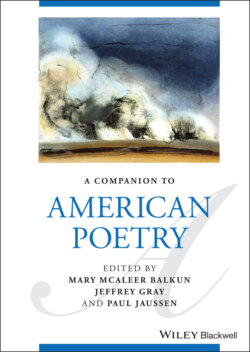Читать книгу A Companion to American Poetry - Группа авторов - Страница 15
NOTES
Оглавление1 1. The Tenth Muse includes twelve pages of prefatory material, including a letter by John Woodbridge, Bradstreet’s brother-in-law who oversaw the publication of this volume, and several poems and anagrams by men who praised and tweaked her by turn. The identity of R.Q. is unknown. For a fuller discussion of this prefatory material, see Kathryn Zabelle Derounian-Stodola (1990) and Gillian Wright (2013, pp. 66–73). Jane D. Eberwein suggests that R.Q.’s commendatory poem was omitted from Several Poems because it suggested that Bradstreet’s representation of monarchies might be read as seditious (1991, p. 139), while Wright suggests that the misogynist humor of the poem undermines the general tone of studied, unthreatened praise found in the other prefatory material (2013, p. 67).
2 2. I use “Ralegh” as the preferred spelling since it is common across recent scholarship.
3 3. Apart from R.Q.’s poem, which was cut from Several Poems, I have used Bradstreet’s later edition of her poems because in it we find subtle differences that, at least in the sections I treat, put greater emphasis on women’s efforts (“plac’d” becomes “built” in her description of Semiramis in “In honour of that High and Mighty Princess, Queen Elizabeth, of most happy memory”) and on slurs on powerful women (in “The Four Monarchies,” again regarding Semiramis, “And that her worth, deserved no such blame” becomes “That undeserv’d, they blur’d her name and fame”). These changes suggest that Bradstreet’s ideas about historical interpretation and representations of women may have been becoming more bold and specific even as she moderated her positions on monarchy.
4 4 As Jane D. Eberwein argues, “if Anne Bradstreet failed as a historian, she did so in part because, in events then being played out in the courts and battlefields of Britain, history itself failed her” (1991, p. 123). Wright suggests that the confusion of the ending may also be attributed to the editorial interference of John Woodbridge, who was arranging its publication after the beheading of the King (2013, pp. 94–96).
5 5. The figure of the Asssyrian Queen Semiramis found in Ralegh’s Historie and Bradstreet’s poetry is rooted in Greek histories of Persia by Diodorus, Herodotus, Plutarch, and others. To a large extent she is an historical fiction, perhaps a composite of two historical queens from the eighth century BCE but with a legend that was thoroughly shaped by Greek perspectives (Stronk 2017, pp. 526-527). She is represented as a great leader who built the walls of Babylon and successfully ruled and expanded the Assyrian empire after the death of her husband Ninus. Some accounts assert that she had her husband killed so she could rule in his stead. Others suggest that she pretended to be her son or had an incestuous relationship with him in order to rule after Ninus’ death. The unreliability of Greek accounts is an important feature in Ralegh’s Historie. Two centuries earlier, Christine de Pizan stresses the gendered valences of historical misrepresentations when she includes Semiramis as the cornerstone of her City of Ladies (1982, pp. 38–40).
6 6. Suzuki argues that “Bradstreet establishes an opposition between monarchism and republicanism, which intersects with another opposition between the genders”, suggesting that her positive treatment of counselors and of female monarchs both privilege an expanded polity (2009, p. 936). In the process, Bradstreet stakes her claim as an epic poet. I highlight instead her emphasis on the process of evaluating interpretations rather than the conclusions she reaches.
7 7. Lady Harriet Acland (1750–1815) was widely known for this act of heroism and devotion. Texts and images drawing on General Burgoyne’s account include an engraving by Robert Pollard of Harriet Acland on the Hudson River. A couple of years before Wentworth published The Virtues of Society, Acland’s story was included in Noah Webster’s An American Selection of Lessons in Reading and Speaking (1797, pp. 50-53).
